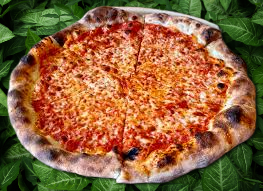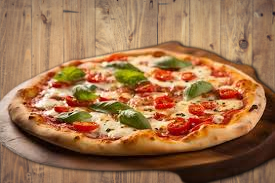Pizza, a universal favorite, has undergone a transformation in recent years, with the rise of the artisanal pizza movement. But what exactly is artisanal pizza? And why has it become so popular? Let’s dive into the delicious world of artisanal pizza and discover what sets it apart from the rest.
Artisanal pizza is more than just a meal; it’s a culinary masterpiece crafted with passion and precision. What distinguishes artisanal pizza is the commitment to quality ingredients, traditional preparation methods, and individual craftsmanship.

Artisanal Pizza
Ingredients for Artisanal Pizza
To create a truly artisanal pizza, every ingredient must be chosen with care.
Flour: The foundation of any good pizza dough is high-quality flour. Artisanal pizza often uses specific types of flour, like ’00’ flour, known for its fine texture and ability to produce a soft, yet chewy crust.
Water: The water used in the dough can significantly impact the final product. The mineral content and purity of the water play a role in the fermentation process and the texture of the dough.
Yeast: Yeast is the driving force behind the dough’s rise. Artisanal pizza makers might use natural starters or specific strains of yeast to develop unique flavors through fermentation.
Salt: Salt is crucial in balancing the flavors and strengthening the dough structure. The type and amount of salt used can subtly alter the taste and texture of the crust.
Toppings: Fresh, high-quality toppings are the hallmark of artisanal pizza. Whether it’s San Marzano tomatoes, fresh mozzarella, or locally-sourced vegetables, the focus is on freshness and flavor.
Dough Making Of Artisanal Pizza
Crafting ideal pizza dough is an art.
Mixing the Dough: Proper mixing ensures all ingredients are well combined and gluten is adequately developed.
Kneading the Dough: Kneading is essential for developing the dough’s structure, ensuring it can hold up to the toppings without becoming too dense.
Fermentation Process: Allowing the dough to ferment properly, often overnight or longer, enhances the flavor and texture, resulting in a crust that’s both airy and chewy.
Shaping the Perfect Crust
The way you shape your dough can make or break your pizza.
Hand-stretching Techniques: Hand-stretching the dough helps maintain its airy structure and creates the perfect base for toppings.
Avoiding Common Mistakes: Overworking the dough or using a rolling pin can lead to a dense, tough crust. Gentle handling is key.
Baking Techniques for Artisanal Pizza
The baking process is where all the preparation comes to fruition.
Choosing the Right Oven: While a wood-fired oven is traditional and imparts a unique flavor, excellent results can be achieved with electric ovens equipped with pizza stones or steels.
Optimal Baking Temperatures: High temperatures, often around 900°F (482°C) for wood-fired ovens, are essential for achieving a crispy, yet tender crust.
Importance of Pizza Stones and Steels: These tools help replicate the intense heat of a traditional oven, ensuring even baking and a perfectly crisp crust
Popular Styles of Artisanal Pizza
Artisanal pizza comes in many styles, each with its own unique characteristics and traditional toppings.
Neapolitan Pizza: Known for its soft, pillowy crust, Neapolitan pizza is traditionally topped with simple ingredients like tomatoes, mozzarella, and basil.
Roman Pizza: With a thin, crispy crust, Roman pizza is often square-shaped and topped with a variety of ingredients, including cured meats and cheeses.
New York-Style Pizza: Characterized by its large, foldable slices and chewy crust, New York-style pizza is typically topped with mozzarella and tomato sauce, but can also feature a wide range of other toppings.
Artisanal Pizza Sauce Recipes
1.Classic Tomato Sauce
Here are two most popular sauces recipes of Artisanal Pizza
Ingredients
– 28 oz crushed San Marzano tomatoes
– 2 tablespoons extra-virgin olive oil
– 3 cloves garlic, minced
– 1 teaspoon sugar
– 1 teaspoon salt
– 1 teaspoon dried oregano
– 1 teaspoon dried basil
– 1/4 tsp red pepper flakes (optional)
– Freshly ground black pepper to taste
Instructions
1. Heat the Olive Oil: In a medium saucepan, heat the olive oil over medium heat.
2. Sauté the Garlic: Add the minced garlic and sauté for about 1 minute, until fragrant but not browned.
3. Add Tomatoes and Seasonings: Pour in the crushed tomatoes, then add sugar, salt, oregano, basil, red pepper flakes (if using), and black pepper. Stir well to combine.
4. Simmer: Bring the sauce to a simmer, then reduce the heat to low and let it simmer gently for about 20-30 minutes, stirring occasionally.
5. Adjust Seasoning: Taste the sauce and adjust seasoning if needed.
6. Cool and Use: Allow the sauce to cool slightly before using it on your pizza.
2.White Garlic Sauce
Ingredients
– 2 tablespoons butter
– 3 cloves garlic, minced
– 2 tablespoons all-purpose flour
– 1 cup whole milk
– 1/2 cup heavy cream
– 1/2 cup grated Parmesan cheese
– 1 teaspoon dried oregano
– 1 teaspoon dried basil
– Salt and pepper to taste
Instructions
1. Melt the Butter: In a medium saucepan, melt the butter over medium heat.
2. Sauté the Garlic: Add the minced garlic and sauté for about 1 minute, until fragrant but not browned.
3. Make a Roux: Sprinkle the flour over the garlic and butter, and whisk continuously for about 1 minute to cook the flour.
4. Add Milk and Cream: Slowly pour in the milk and cream, whisking constantly to prevent lumps.
5. Add Cheese and Seasonings: Stir in the grated Parmesan cheese, oregano, basil, salt, and black pepper. Continue to beat until the sauce sets, about 3-5 minutes.
6. Simmer and Thicken: Reduce the heat to low and let the sauce simmer gently for another 2-3 minutes, until it reaches your desired thickness.
7. Cool and Use: Allow the sauce to cool slightly before using it on your pizza.
Artisanal Pizza Recipes
1.Classic Margherita Pizza
Ingredients
– 1 ball of pizza dough
– 1/2 cup classic tomato sauce (see recipe above)
– 8 ounces fresh mozzarella cheese, sliced
– Fresh basil leaves
– 2 tablespoons extra-virgin olive oil
– Salt and pepper to taste
Instructions
1. Preheat the Oven: Preheat your oven to the highest temperature (usually around 500°F or 260°C). Preheat pizza stone in oven.
2. Prepare the Dough: Roll out the pizza dough on a lightly floured surface to your desired thickness.
3. Add Sauce: Spread the classic tomato sauce evenly over the dough, leaving a small border around the edges.
4. Add Cheese: Arrange the fresh mozzarella slices evenly over the sauce.
5. Bake: Transfer the pizza to the oven (use a pizza peel if you have one) and bake for 10-12 minutes, or until the crust is golden and the cheese is bubbly and slightly browned.
6. Add Basil and Oil: Remove the pizza from the oven and immediately scatter fresh basil leaves over the top. Drizzle with olive oil, salt, and pepper.
7. Serve: Slice and serve hot.
2.Prosciutto and Arugula Pizza
Ingredients
– 1 ball of pizza dough
– 1/2 cup classic tomato sauce (see recipe above)
– 8 ounces fresh mozzarella cheese, sliced
– 4-6 slices of prosciutto
– 1 cup fresh arugula
– 2 tablespoons extra-virgin olive oil
– 1 tablespoon balsamic glaze (optional)
– Salt and pepper to taste
Instructions
1. Preheat the Oven: Preheat your oven to the highest temperature (usually around 500°F or 260°C). – Preheat pizza stone in oven.
2. Prepare the Dough: Roll out the pizza dough on a lightly floured surface to your desired thickness.
3. Add Sauce: Spread the classic tomato sauce evenly over the dough, leaving a small border around the edges.
4. Add Cheese: Arrange the fresh mozzarella slices evenly over the sauce.
5. Bake: Transfer the pizza to the oven (use a pizza peel if you have one) and bake for 10-12 minutes, or until the crust is golden and the cheese is bubbly and slightly browned.
6. Add Prosciutto and Arugula: Remove the pizza from the oven and immediately place the prosciutto slices over the top. Scatter fresh arugula on top of the prosciutto.
7. Drizzle with Oil and Glaze: Drizzle extra-virgin olive oil and balsamic glaze (if using) over the arugula. Season with salt and pepper.
8. Serve: Slice and serve hot.
Pairing Pizza with Beverages
The right beverage can elevate your pizza experience.
Wine Pairings: Light red wines like Chianti or a crisp white like Pinot Grigio complement the flavors of artisanal pizza without overpowering them.
Beer Pairings: A cold, crisp lager or a hoppy IPA can cut through the richness of the cheese and toppings, providing a refreshing balance.
Non-alcoholic Options: Sparkling water or a classic soda can also pair wonderfully with pizza, cleansing the palate between bites.
Nutrition in Artisanal Pizza
| Nutrient | Amount per Serving |
|---|---|
| Calories | 250-300 kcal |
| Carbohydrates | 30-35 g |
| Protein | 10-15 g |
| Fat | 10-15 g |
| Saturated Fat | 4-6 g |
| Cholesterol | 20-30 mg |
| Fiber | 2-4 g |
| Sugar | 2-5 g |
| Sodium | 500-700 mg |
| Vitamin A | 10-15% DV |
| Vitamin C | 10-20% DV |
| Calcium | 15-20% DV |
| Iron | 10-15% DV |
Key Nutritional Insights
– Balanced Macronutrients: Artisanal pizza provides a balanced mix of carbohydrates, protein, and fats, making it a more rounded meal option compared to fast-food pizzas.
– Quality Ingredients: The use of high-quality, fresh ingredients can enhance the nutritional profile, offering more vitamins, minerals, and antioxidants.
– Moderation is Key: While artisanal pizza can be part of a healthy diet, portion control is essential to manage calorie intake and nutrient balance.
Tips for Making Artisanal Pizza at Home
Making artisanal pizza at home can be incredibly rewarding with the right approach.
Investing in a good pizza stone, peel, and a high-quality oven can make a significant difference.
Seek out the best ingredients you can find, from flour to cheese to fresh toppings.
Common problems like soggy crusts or uneven baking can often be resolved with a few adjustments in technique or equipment.
Artisanal pizza is a celebration of tradition, quality, and craftsmanship. Whether you’re enjoying it at a local pizzeria or making it at home, the care and attention to detail that goes into each pizza make it a truly special experience. So, roll up your sleeves, gather your ingredients, and start crafting your own artisanal pizza masterpiece. Artisanal pizza is not only a treat for the taste buds but also offers a better nutritional profile compared to many commercial pizza options. By focusing on fresh, high-quality ingredients and balanced portions, you can enjoy this culinary delight as part of a healthy diet.
FAQs
What is the difference between artisanal pizza and regular pizza?
Artisanal pizza focuses on high-quality ingredients, traditional methods, and craftsmanship, while regular pizza often uses mass-produced ingredients and methods.
Can I make artisanal pizza without a wood-fired oven?
Yes, while a wood-fired oven is traditional, you can achieve excellent results with a regular oven using a pizza stone or steel.
What are some vegan topping options for artisanal pizza?
Fresh vegetables, vegan cheeses, and plant-based meats make great vegan topping options.
How to achieve a crispy crust on homemade pizza?
Using a pizza stone or steel, baking at high temperatures, and ensuring your dough is properly fermented can help achieve a crispy crust.
What are the best cheeses to use for artisanal pizza?
Mozzarella, Parmesan, and Ricotta are popular choices, but experimenting with other cheeses like Gorgonzola or Pecorino can add unique flavors.


